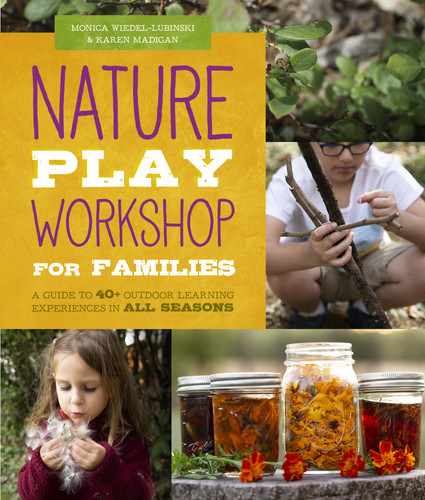2
Seasonal Nature Play:
AUTUMN
Fading light, colorful leaves, and crisp air signal the arrival of fall. The autumnal equinox means less daylight as darkness falls sooner than in summer. Plants and animals are keen to prepare for colder weather now that a chill is in the air. With cozy scarves and warm mugs of tea, we are ready for another beautiful season of nature play.
FRUITS IN FALL
by Monica Wiedel-Lubinski
Pears and apples on the trees,
Hanging low in autumn’s breeze.
Squash and pumpkins on the vine,
Pick them now, they’re ripe and fine.
Harvest, gather, taste them all,
We give thanks for fruits in fall.
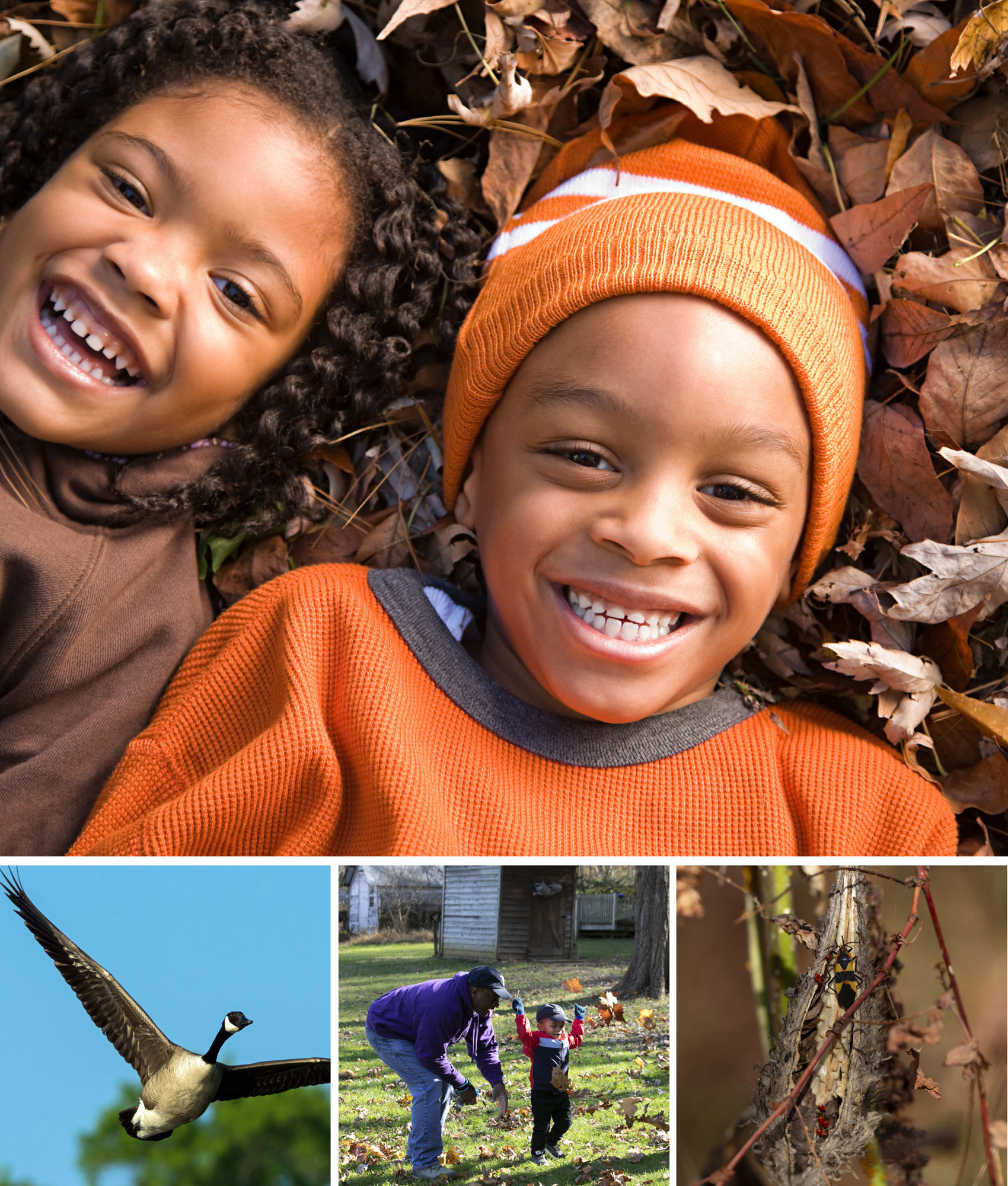
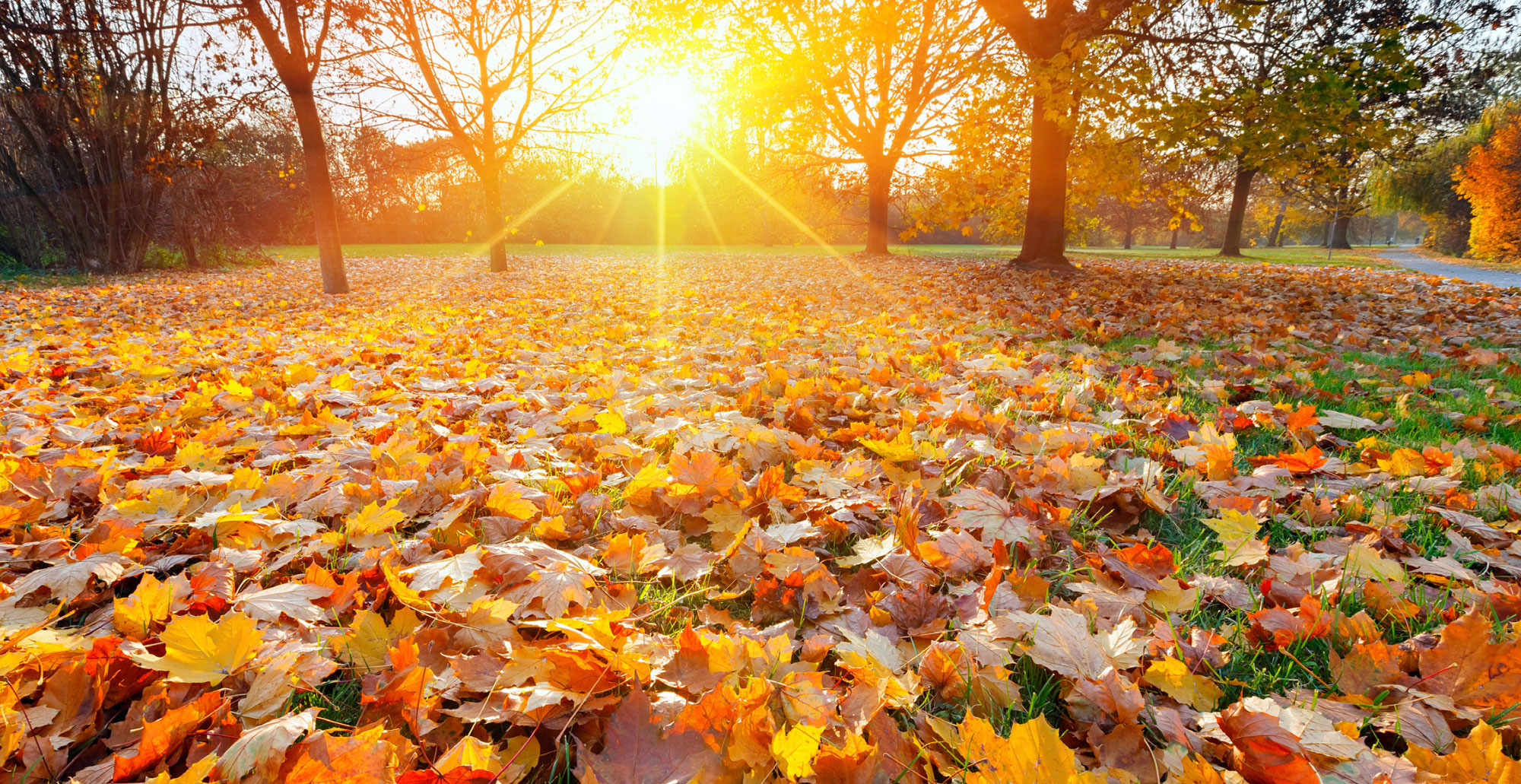
CHANGING SKY
NATURE PLAY EXPERIENCE
Venture outdoors as daylight dwindles and twilight sets in. Notice insect calls and the movement of bustling birds as they settle into evening darkness. Where do crickets and spiders go at night? What are squirrels and chipmunks doing? Which birds seem most active now? What other animals might be waking up as night falls? Look for clues that help tell the story of these animals at dusk.
MAKE IT WILD: LEAF LANTERNS
Evening holds a magic all its own in autumn.
Use colorful leaves from the season to create a glowing lantern.
MATERIALS
〉 Assorted pressed leaves
〉 Grapevine, bittersweet, or wisteria vine clippings
〉 Tacky craft glue
〉 Shallow dish for glue (like a clean lid or yogurt container)
〉 Flat brush to spread glue
〉 Clean jam, pasta sauce, or canning jar (the bigger, the better)
〉 Scraps of white or light-colored gift tissue paper
〉 Cotton or hemp twine
〉 Battery-operated tea light
PROCESS
1. Gather an assortment of colorful leaves during nature play.
2. Press the leaves between heavy book pages for at least 1 week.
3. Once leaves are pressed, gather vine clippings so they are fresh for use. (If you gather vines ahead of time, soak them in warm water to ensure they are soft and pliable.)
4. Squeeze some tacky glue into a shallow dish and use a brush to cover the jar with the glue.
5. Press and smooth tissue paper and leaves onto the glue-covered jar.
6. Use a thin layer of glue to cover and seal all of the leaves on the lantern. Set it aside to dry.
7. Add twine and vines to embellish the top of the lantern.
8. Turn on the tea light, place it in the lantern, and enjoy the glow!
Note: Remember to clean your brush and glue dish to use them again.
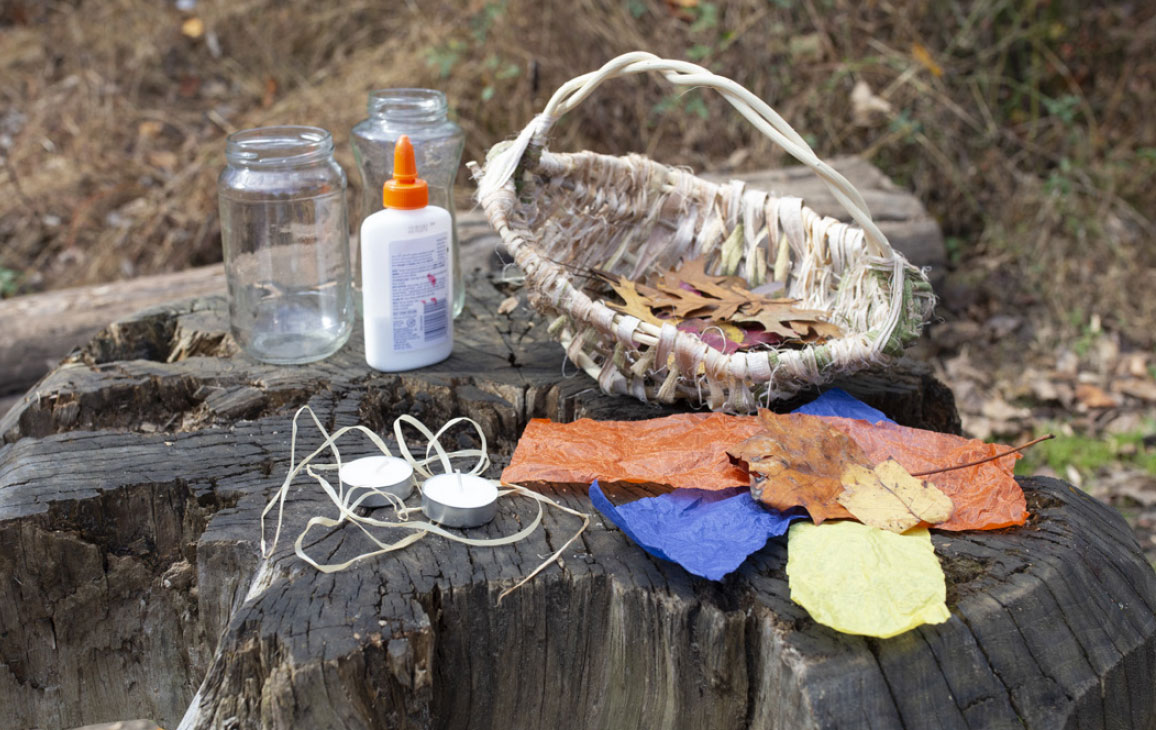

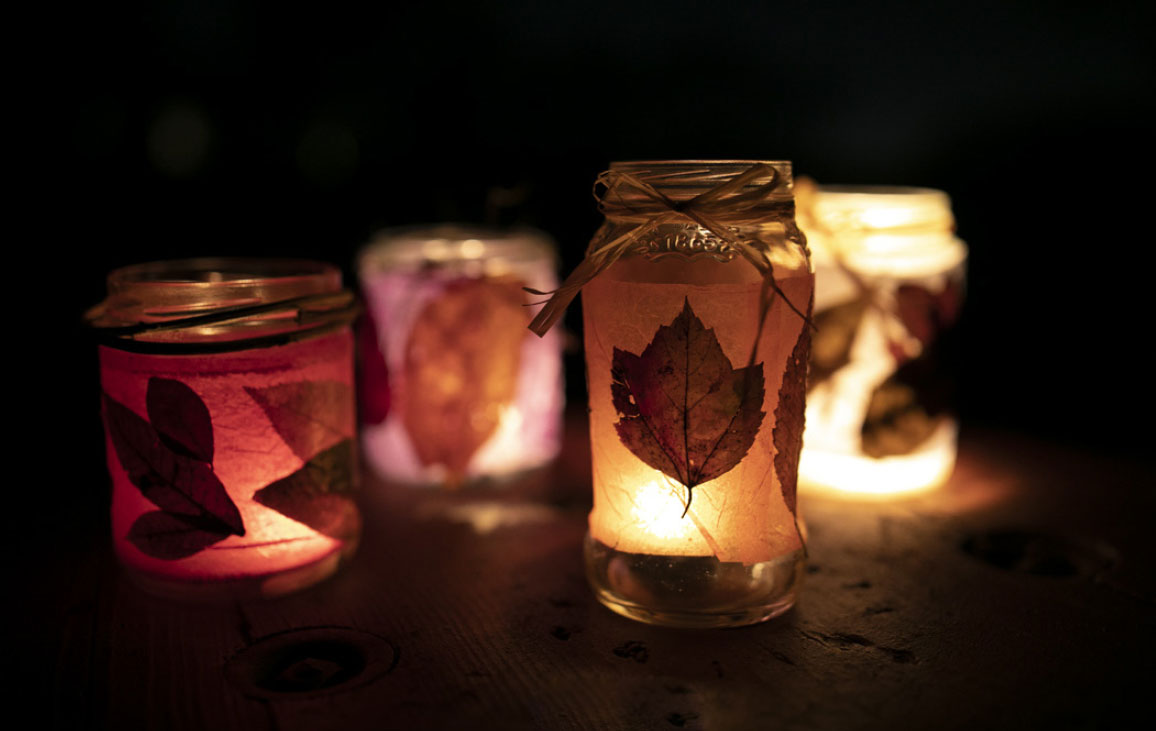
KEEP IT WILD
Leaf lanterns are enchanting luminaries, but if you want to turn on your own night vision, don’t use artificial light at all. Let your eyes gradually adjust as dusk becomes night, and let your wild instincts kick in.
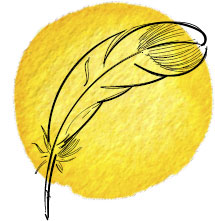 EXTENDING THE EXPERIENCE
EXTENDING THE EXPERIENCE
Many cultures have seasonal celebrations of light. Consider starting an autumn solstice tradition with your family, neighborhood, or school.

SEEDS
NATURE PLAY EXPERIENCE
Seeds roll, float, fly, or hitch a ride to find fertile ground, and they are literally bursting to find homes in autumn. Explore a park or yard to gather and examine fall seeds. What seeds can you find? Remember, nuts like acorns are seeds and fall fruits cleverly conceal seeds too! How many different kinds of seeds can you find? Notice the variety of types, colors, and sizes in your area. What can we learn about where a seed grows based on its shape?
MAKE IT WILD: SEED SPIRAL
Most of us can appreciate the aesthetic beauty of the natural world. Artists like Andy Goldsworthy exemplify using nature to make temporary outdoor works of art.
PROCESS
1. Locate a clearing or glen to create the seed spiral. If you’d like to use it for a walking meditation, be sure to leave at least 3 feet (1 m) of space between the lines of the spiral for walking.
2. Gather a variety of seeds, fallen branches,
and leaves.
3. Place seeds and other natural objects on the ground to make a large spiral.
4. Walk the spiral and invite others to experience your creation.
Your seed spiral will change over time as the weather, animals, and other forces of nature interact with it. Some seeds may even sprout in the spring! Visit your spiral often to see how it evolves. You can keep adding natural materials to it each time you visit or let nature take its course.



KEEP IT WILD
Many animals make food caches to prepare for winter. Leave plenty of seeds for the animals and expect that some will go missing from your seed spiral!
 EXTENDING THE EXPERIENCE
EXTENDING THE EXPERIENCE
Experiment with the seeds to see what will grow. Plant some of these seeds now or let them harden in the freezer (which simulates winter) and save them for planting in the spring. Use your nature journal to record the date you planted the seeds. Make predictions about when they may sprout and what the seeds may grow into.
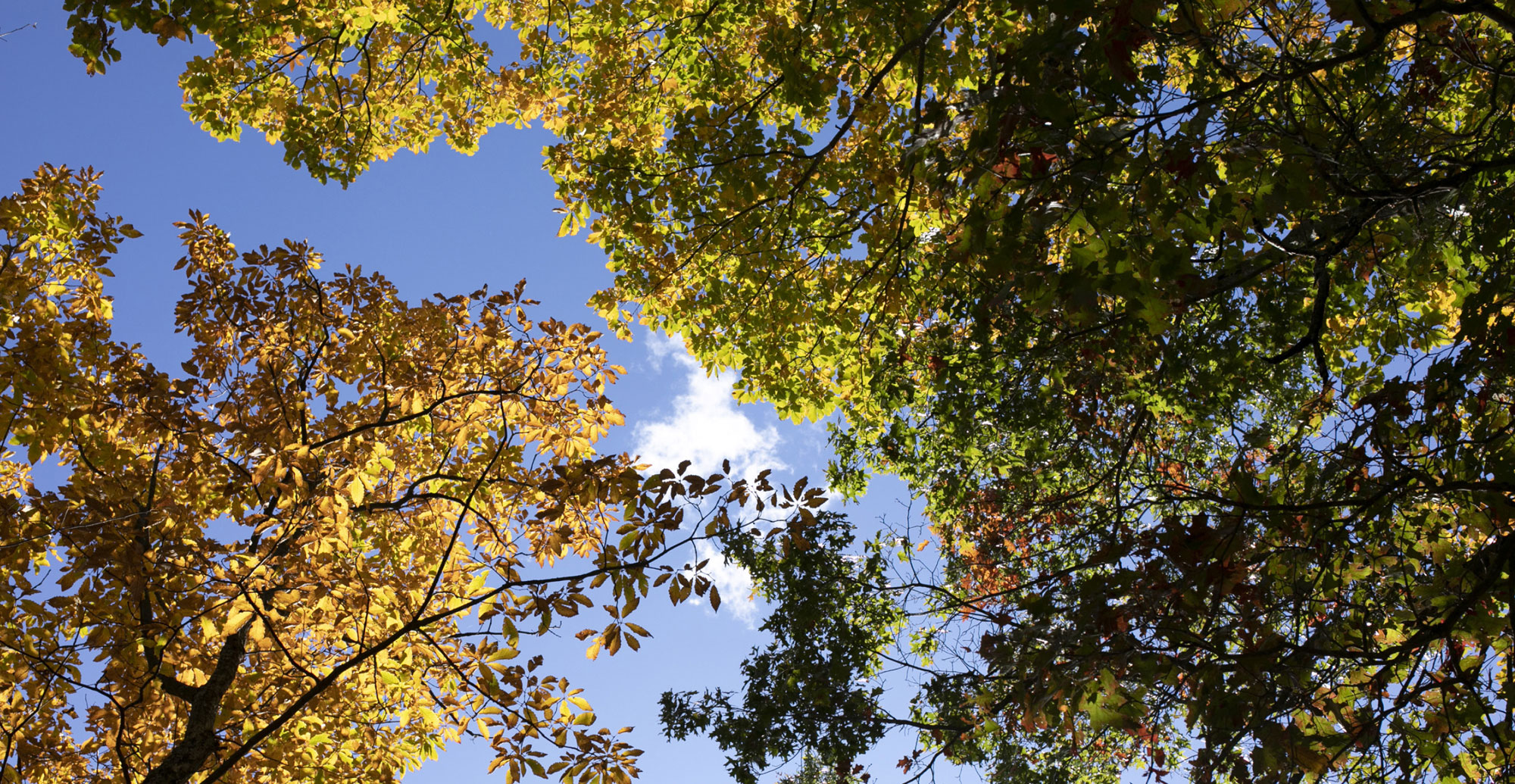
LEAVES
NATURE PLAY EXPERIENCE
Trek a leafy trail. Breathe in the scent of fall leaves. Feast your eyes on the colorful blanket of leaves above, below, and gently adrift in the sky. What colors dominate the tree silhouettes? Can you detect movement from animals hidden among fall foliage? As you play, gather favorite fall leaves to use in your leaf crown.
MAKE IT WILD: LEAF CROWNS
Become king or queen of the forest with these sweet autumn crowns.
MATERIALS
〉 Assorted leaves and grasses
〉 Clean pizza box lid
〉 Adult scissors
〉 Large embroidery needle
〉 Hemp twine or embroidery floss
PROCESS
1. Gather a basket full of colorful leaves and grasses.
2. Cut the pizza box lid into strips 2 inches (5 cm) wide by 20 inches (50 cm) long. (You may need an adult to help you cut through the thick cardboard.)
3. Test the sizing around your head with one of the strips.
4. Thread the needle with a piece of embroidery floss about the length of your arm and knot it at the end.
5. Arrange the first leaf onto the crown and stitch it into place. Continue adding leaves and stitches until the leaf crown is finished.
6. Stitch the ends of the cardboard to tie off the crown to wear it.
Note: Before you begin sewing, trying to poke the needle through the cardboard to see how hard you need to push. It helps to wiggle the needle in place and then push it through.



KEEP IT WILD
If you come upon millipedes, pill bugs, caterpillars, worms, or other tiny creatures on your leaf search, gently replace them just as you found them. Remember, we share nature with all living things.
 EXTENDING THE EXPERIENCE
EXTENDING THE EXPERIENCE
Here are a few more ideas for leaf exploration:
• Grab an old pillowcase and fill it with leaves to make a leafy sit-upon.
• Try to match leaf colors with watercolor paints, then paint the backs of the leaves to make prints in your nature journal.
• See how many leaf shapes you can find (oval, star, heart, and so on), then try to identify the trees they are from.

FROST
NATURE PLAY EXPERIENCE
Legend has it that Jack Frost flies before dawn to conjure up sparkling frost over the land when cold autumn nights turn to day. Bundle up one early morn to see for yourself! Where do you notice the most frost? Are there any nooks where no frost formed? Notice how the leaves glisten like glass. Take a deep breath and savor a moment of gratitude for the beauty of the season. When you exhale, can you see the warm vapor of your breath hanging in the cold air? Make a prediction: how long will the frost stay today?
MAKE IT WILD: JACK FROST GLAZE
This salt solution mimics the crystal structures that form when dew turns to icy frost.
MATERIALS
〉 2 cups (500 ml) water
〉 Pot
〉 1 1/4 cups (300 g) Epsom salt
〉 3–4 drops liquid dish soap
〉 Paintbrush
〉 Watercolor tray
〉 Sturdy watercolor paper or nature journal
PROCESS
1. Bring water to a boil in the pot.
2. Add the Epsom salt and stir until fully dissolved. Set aside to cool to warm.
3. When the salt water is warm (not boiling hot), add the drops of dish soap.
4. Dip the paintbrush first in the saltwater solution and then in the watercolor paint of your choice, then paint onto paper.
5. Once dry, you’ll see how the salt crystal “frost” forms when water evaporates.
Note: Jack Frost glaze can be mixed with watercolor paint, food coloring, or ink. It can even be brushed onto a window pane or a bouquet of fall leaves to create a frosty effect. Be patient! You won’t see the frosty effect until glaze is completely dry.


KEEP IT WILD
It’s helpful to bundle up in waterproof mittens instead of fleece or knit ones. That way you can enjoy cold weather play without wet hands.
 EXTENDING THE EXPERIENCE
EXTENDING THE EXPERIENCE
If frost is on the ground, it’s an ideal time for a morning fire! Sip tea or enjoy a warm bowl of oatmeal fireside.
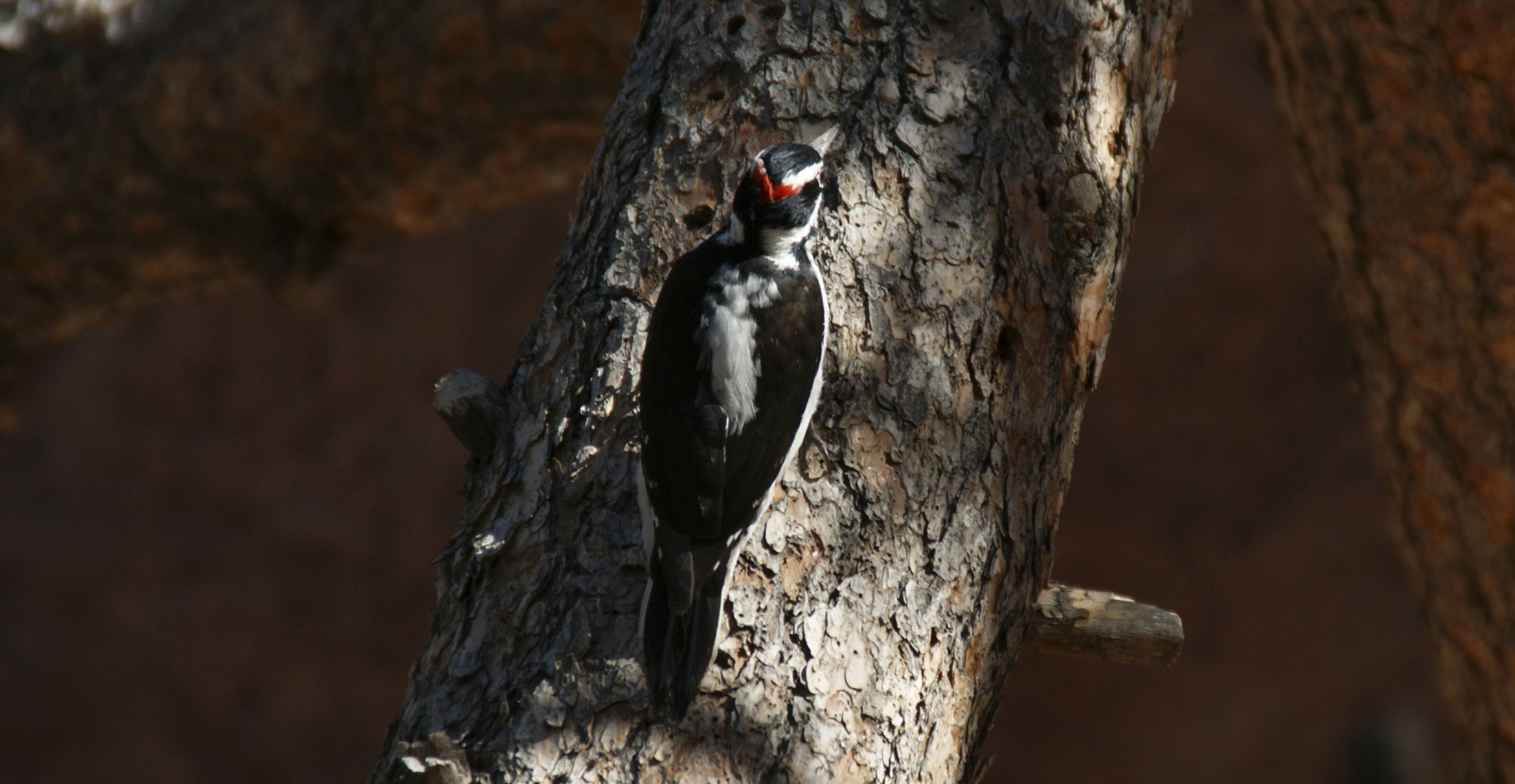
BIRDS
NATURE PLAY EXPERIENCE
Observe birds in autumn as they prepare for the colder weather to come. Do you notice the birds changing their tunes? Look around to detect changes in food for the birds. (Do you hear as many insects? Or notice plentiful berries?) If falling leaves have changed colors, does the array of hues help birds search for food? How do autumn colors help birds protect themselves? How can you help make sure the birds and other animals have the food they need? Gather some treasures such as pinecones or magnolia seedpods to make a beautiful and healthy treat for your animal friends.
MAKE IT WILD: PINECONE AND MAGNOLIA POD BIRD FEEDER
Use plentiful seedpods from nearby pine trees or magnolias to make a mobile that the birds are sure to love.
MATERIALS
〉 Seedpods
〉 Sturdy branch or stick
〉 Twine or ribbon
〉 Vegetable shortening, enough to spread evenly on your seedpods
〉 Spoon or butter knife for spreading shortening
〉 Birdseed in wide bowl
〉 Scissors
PROCESS
1. Gather seedpods and a sturdy stick during nature play.
2. Tie a length of twine or ribbon around each seed pod (about 6 to 12 inches [15 to 30 cm] long), then tie each seedpod onto your stick.
3. Spread the vegetable shortening on each seedpod.
4. Roll the seedpods in birdseed. Cover with as much seed as you can!
5. By now your hands are probably slippery, so wash them off if you need to.
6. Add a final piece of ribbon or twine at each end of the stick for hanging, then place the feeder somewhere you can watch the birds enjoy it.



KEEP IT WILD
When nature sheds leaves, many critters take shelter under them. Rake up a big pile of leaves that can remain in your yard, and you’ll make another kind of bird feeder while you’re at it! Likewise, when you put the garden to bed in autumn, leave the bare flowerheads for the birds to pluck.
 EXTENDING THE EXPERIENCE
EXTENDING THE EXPERIENCE
For a fun take on suet cakes for your bird-feeding station, mix melted vegetable shortening with birdseed and dried fruits, then pour the mixture into paper-lined muffin tins. Lay a piece of ribbon in each “birdseed muffin” and cool in the fridge.

HARVEST
NATURE PLAY EXPERIENCE
Many plants and trees bear fruit during autumn’s harvest. Go on a fruit search! What berries and fruits can you spy? Search in meadow grasses or along forest edges in the shrubs. Instead of picking these fruits, leave them for native animals to enjoy. Take photographs of the fruits you find and try to identify which plants produced them. You may be surprised to discover the bounty of berries at this time of year.
MAKE IT WILD: PUMPKIN APPLE SOUP
If you can visit a local pumpkin patch or apple orchard, now is the time to do it! Harvest these ingredients for a satisfying autumn soup.
MATERIALS
〉 1 sugar or pie pumpkin
〉 Olive oil
〉 3 apples (peeled, cored, and diced into cubes)
〉 1 cup (160 g)
chopped onion
〉 1–2 garlic cloves to taste, finely chopped
〉 3 tablespoons
(45 g) butter
〉 2–3 tablespoons
(30–45 ml) honey or brown sugar
〉 1/4 teaspoon ground nutmeg
〉 1/4 teaspoon cinnamon
〉 3 cups (720 ml) vegetable broth
〉 1/2 cup (120 ml) heavy whipping cream
〉 1/2 cup (120 ml) fresh apple cider
〉 Roasted pumpkin seeds for garnish
PROCESS
1. Preheat the oven to 350°F (180°C or gas mark 4).
2. Remove the pumpkin stem and seeds and slice the pumpkin into wedges. Drizzle with olive oil and place on parchment-lined baking sheet.
3. Roast the pumpkin until tender, about 40 to 50 minutes. Meanwhile, steam the apples until tender, about 10 minutes, then let cool.
4. Scoop the pumpkin flesh into a bowl. It will separate nicely from the skin when tender. Puree the cooked pumpkin and apple, then set aside.
5. Lightly sauté the chopped onions and garlic in butter on low heat until soft and golden brown.
6. Mix the pumpkin, apple, garlic, onion, honey, nutmeg and cinnamon in a bowl; puree again.
7. Warm the vegetable broth on low in a saucepan.
8. Add the puree to the broth, followed by the heavy whipping cream and cider. Stir slowly until combined. Add salt and/or more honey to taste.
9. Puree with an immersion hand blender or food processor for a creamy texture.
10. Serve warm with roasted pumpkin seeds on top.
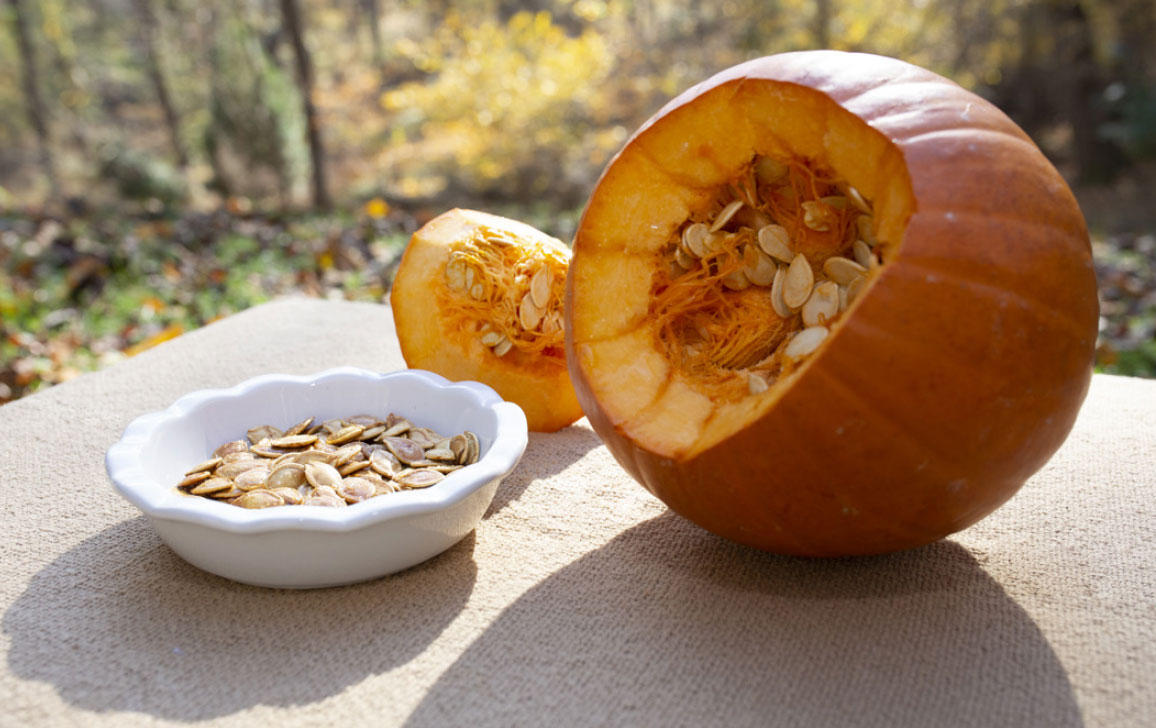


KEEP IT WILD
Some berries are harmful if ingested. Young children can become adept at berry identification, but no child should eat wild berries without permission.
 EXTENDING THE EXPERIENCE
EXTENDING THE EXPERIENCE
Compost the kitchen scraps from your recipe. Pumpkin stems, apple peels, and onion skins are perfect for compost pile and a great way to enrich your garden soil.

RETURNING TO SOIL
NATURE PLAY EXPERIENCE
Explore a wild space to observe autumn flowers, grasses, shrubs, and trees. Which plants and plant parts have faded or fallen to the ground? How will these natural objects return to the soil? Do you think they will decompose or sprout next spring?
Scout the area for rotting logs and examine them closely. How does the bark feel? Rough and sturdy? Spongy and soft? What is growing on or near the log? Choose a log and gently roll it away from you as if you are opening the front door to a hidden home. Watch quietly for a few moments to observe movement under the log. What can you spy under this log? When you are finished, gently roll the log back into place to “close the door” and respect this habitat.
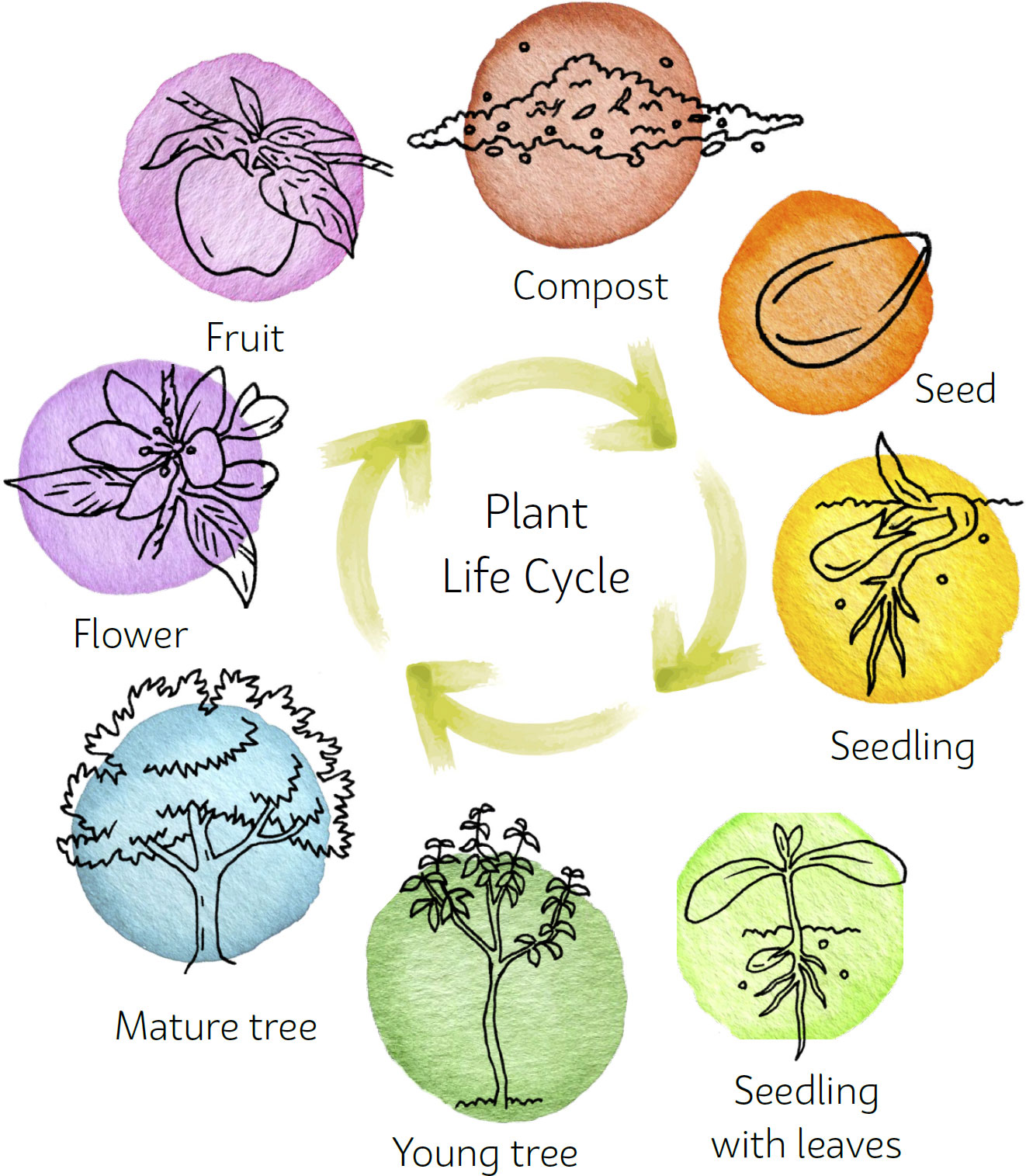
MAKE IT WILD: WILL IT ROT?
Conduct a simple experiment to discover how long these items will take to return to the soil.
MATERIALS
〉 Natural items such as evergreen needles, leaves, flowerheads, rocks, grass cuttings, fruit peels, or twigs
〉 Manufactured items such as a plastic bag, wrapper, or empty juice box, and cardboard box
〉 Container filled with soil
〉 Hand trowel (optional)
PROCESS
1. Gather your materials to use in the experiment.
2. Determine the length of the experiment, the longer the better (6 months, for example).
3. Make and record your predictions about which materials will decompose first.
4. Bury assorted natural and human-made materials in the container of soil.
5. Note where you bury each material along with your predictions.
6. Leave the container exposed to the weather for the designated period of days, weeks, or months.
7. Check on the materials at intervals (for example, once per month for 6 months) and photograph how they change.
8. When the experiment is done, compare the decomposition of materials to see if your prediction was correct. What broke down the fastest? Slowest? Did anything disappear?

KEEP IT WILD
Vermicompost and other compost piles are a great way to let nature decompose our food waste. Instead of sending it out with the trash headed to a landfill, compost at home to make nutrient-rich soil for the garden.
 EXTENDING THE EXPERIENCE
EXTENDING THE EXPERIENCE
Plants experience growing cycles of life and death as they move through the seasons. Many plants wither and die after fruiting. The process of decomposition breaks down leaves, seedpods, and stems and gradually returns them back into the soil. These enriching nutrients help new plants grow.

FORAGING
NATURE PLAY EXPERIENCE
There is still time to gather plants before they fade! Grab your favorite basket and go on a wander to look for common wood sorrel (Oxalis acetosella) and spearmint (Mentha spicata). There are many species of mint commonly found in herb gardens, such as peppermint or lemon balm, that make delicious tea.
Note: Avoid foraging along roadsides and other areas that may be treated with herbicides and pesticides.
MAKE IT WILD: SORREL AND MINT TEA
This is a refreshing tea that is easy to forage and tastes great warm or cold!
MATERIALS
〉 11/2 cups (375 ml) water
〉 2 tablespoons (12 g) fresh wood sorrel
〉 2 tablespoons (12 g fresh, 3 g dried) fresh or dried mint leaves
〉 Cheesecloth or sieve (a drawstring cheesecloth bag works well)
〉 Fresh squeezed lemon juice (optional)
〉 Honey to taste (optional)
PROCESS
1. Boil the water in a tea kettle.
2. Place the fresh wood sorrel and mint leaves into a pot.
3. Pour the boiling water over leaves and let sit for 5 minutes.
4. Strain the tea leaves using cheesecloth or a sieve.
5. Add a fresh squeeze of lemon juice or a dollop of honey to taste and stir well.
6. Enjoy your refreshing tea!
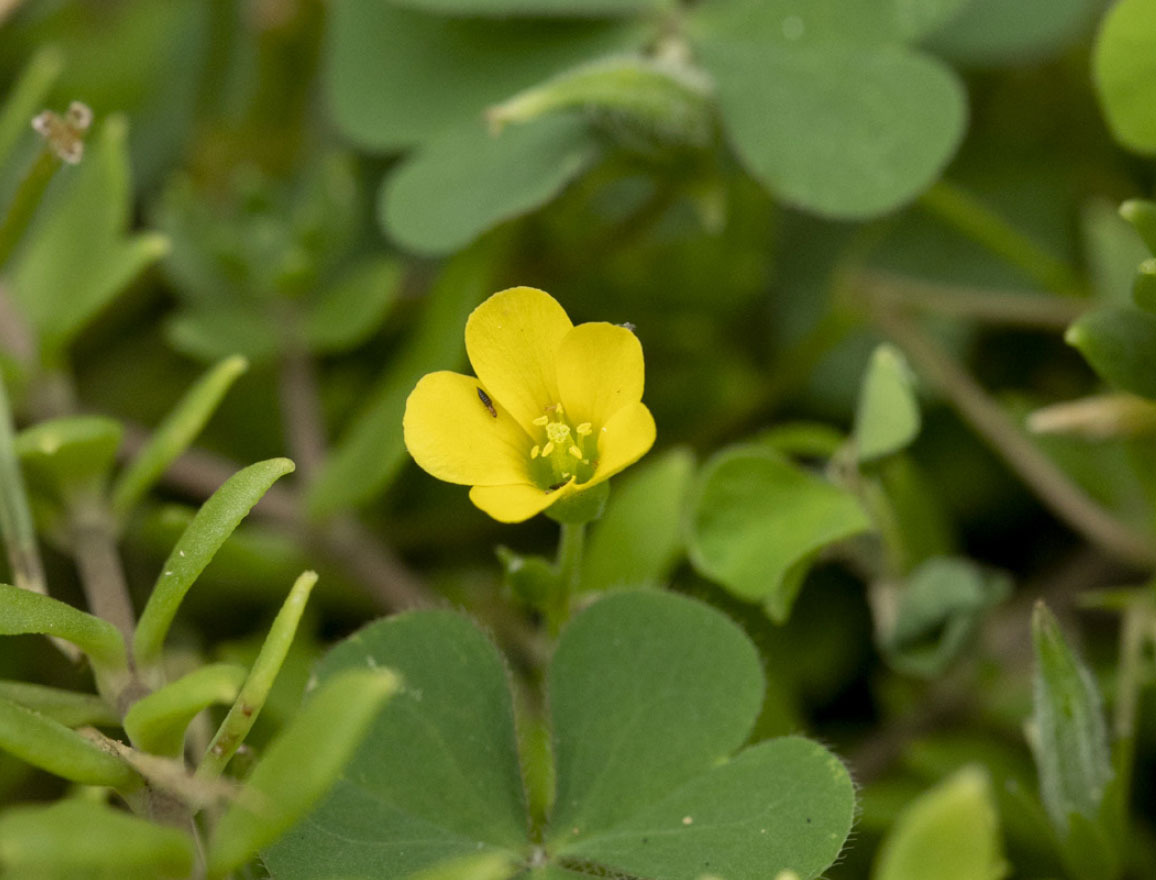


KEEP IT WILD
Have bunches of fresh spearmint? Freeze it in ice cubes for a cold, refreshing glass of water or mint-flavored iced tea. Fresh mint can also be used in berry smoothies, couscous and quinoa dishes, lime-seasoned snap peas, or watermelon and feta salad. It’s a great introduction to many healthy recipes for your family to try when you forage this sweet, minty herb and cook together.
 EXTENDING THE EXPERIENCE
EXTENDING THE EXPERIENCE
Spicebush (Lindera benzoin) is plentiful in the understory of many North American forests. You can forage and dry the bright red berries and, when crushed, use them in place of allspice. Some call it “Appalachian Allspice” because of the bright, versatile flavor. Take time to discover how indigenous people where you live use spicebush—and countless other plants—for a variety of medicinal and dietary purposes.

ROOSTS AND DENS
NATURE PLAY EXPERIENCE
Take a wander in the woods to gather branches and sticks; they’re especially easy to find after a windy fall day. This simple task often leads to the discovery of tiny creatures, plants, or fungi that make use of fallen branches. What lives on or beneath sticks? Is there a den hidden beneath a roof of fallen branches? Are there roosting nooks in hollow tree branches or abandoned nests? Sticks provide shelter and microhabitat for many creatures. Observe how this plentiful material supports wildlife around you in autumn. As you wander exploring sticks, scout out trees and sturdy shrubs you can lean branches on.
MAKE IT WILD: STICK FORT
Use baskets to hold small gathered twigs and make piles of larger branches. An assortment of sizes may be useful, depending on the size of your fort. Remember to use freshly fallen sticks from the trees. Bypass branches that are already decaying and inhabited by small animals. If you opt to build your fort near a bird feeder, you can quietly hunker down hidden from view and watch the birds.
MATERIALS
〉 Various size branches
〉 Leaves, grasses, or vines for outer covering (optional)
〉 Twine or nylon cord (optional)
PROCESS
1. Locate an ideal spot for your fort. (The crook of a tree 3 to 4 feet [1 to 1.2 m] from the ground makes a good starting point.)
2. Lean a long branch in the crook of the tree to create a central branch to lean others on.
3. Place branches perpendicular to the central branch to create walls.
4. Once the walls are in place, add leaves or bundles of grass to camouflage the fort.
5. When the fort is in place, you can add windows, a door, or other embellishments.
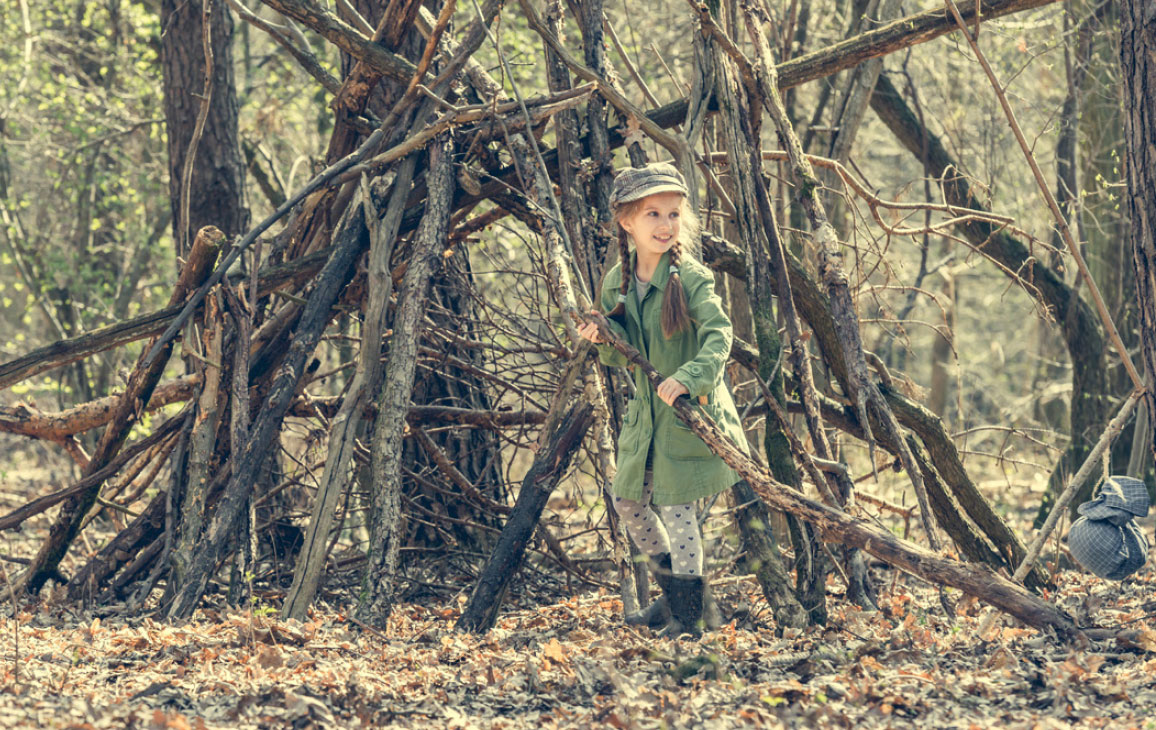
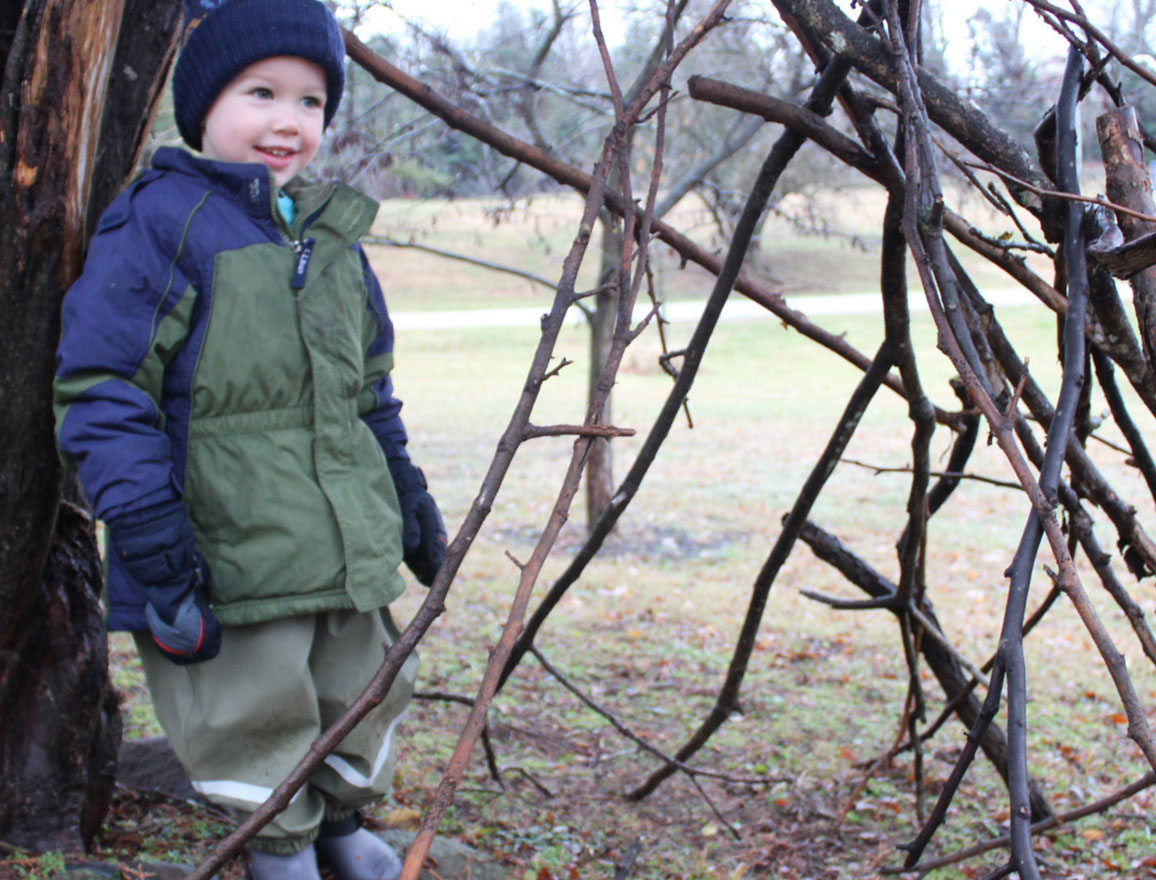

KEEP IT WILD
As you gather sticks for the fort, let rotting branches lie. They provide important food and shelter for small animals. Besides, they will likely fall apart if you try to use them for construction. As with all collecting, take only what you need, and use everything you take.
 EXTENDING THE EXPERIENCE
EXTENDING THE EXPERIENCE
Experiment with ways to create an original freeform fort. This is an engineering exercise of balanced design that will take patience and time, and it is far more fun with friends! While there are elaborate debris huts and shelters that are substantial enough for people to survive extreme cold, yours need not be fussy. Enjoy creating a cozy fort that feels just right for your nature play.
Note: Learn about the indigenous keepers of the land you frequent as a form of respect and to acknowledge past and present ways of knowing and being on the land. Teepees, wickiups, longhouses, and adobe houses are just a few examples of shelters indigenous people created in various parts of the world.
